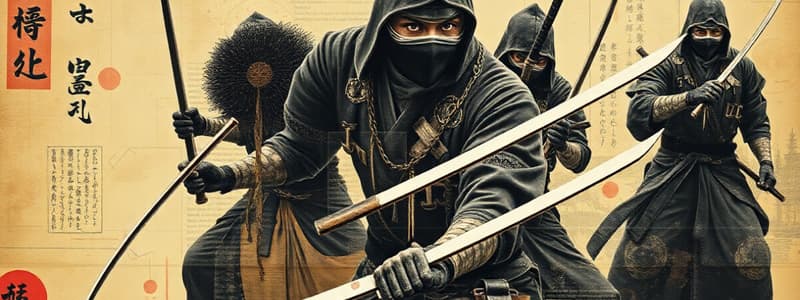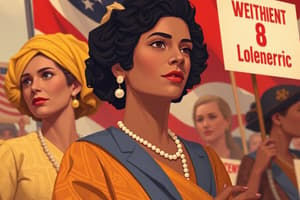Podcast
Questions and Answers
What is the primary focus of the new international ninja research center?
What is the primary focus of the new international ninja research center?
- To separate historical facts from myths about ninjas (correct)
- To promote modern ninja martial arts
- To create new ninja folklore
- To document popular ninja films and novels
In which region did Japanese people begin associating elements of traditional warfare with shinobi?
In which region did Japanese people begin associating elements of traditional warfare with shinobi?
- Kyoto
- Iga (correct)
- Tokyo
- Osaka
What year marks the first appearance of historical records related to ninjas?
What year marks the first appearance of historical records related to ninjas?
- 1800
- 1600
- 1541 (correct)
- 1700
What was the original meaning of the term 'shinobi' when it first appeared?
What was the original meaning of the term 'shinobi' when it first appeared?
What influenced the image of the black-clad ninja in Japanese art?
What influenced the image of the black-clad ninja in Japanese art?
Who collaborated to promote the Iga region as the 'heartland of the ninja' in the mid-20th century?
Who collaborated to promote the Iga region as the 'heartland of the ninja' in the mid-20th century?
Which event first sparked the legend of ninjas in recorded history?
Which event first sparked the legend of ninjas in recorded history?
What was a significant result of military manuals published in the 18th century?
What was a significant result of military manuals published in the 18th century?
What does the new international ninja research center aim to analyze?
What does the new international ninja research center aim to analyze?
What type of historical documents will the research center house?
What type of historical documents will the research center house?
What factor contributed to the transformation of the term 'shinobi' from an adverb to a noun?
What factor contributed to the transformation of the term 'shinobi' from an adverb to a noun?
How was the idea of the black ninja robe popularized in Japan?
How was the idea of the black ninja robe popularized in Japan?
What was one of the innovative strategies used to promote Iga as the 'heartland of the ninja'?
What was one of the innovative strategies used to promote Iga as the 'heartland of the ninja'?
Which aspect of ninja lore became prominent due to the merging of various elements of warfare in Japan?
Which aspect of ninja lore became prominent due to the merging of various elements of warfare in Japan?
What misleading association did the mid-20th century promotion of ninjas create?
What misleading association did the mid-20th century promotion of ninjas create?
What common theme is found across historical ninja narratives?
What common theme is found across historical ninja narratives?
What key aspect contributed to the establishment of the ninja research center's mission to decode ninjas?
What key aspect contributed to the establishment of the ninja research center's mission to decode ninjas?
Which specific historical event in 1541 is identified as a turning point in the recorded history of ninjas?
Which specific historical event in 1541 is identified as a turning point in the recorded history of ninjas?
Which phrase describes the transition of shinobi in historical narrative from the 16th to 17th century?
Which phrase describes the transition of shinobi in historical narrative from the 16th to 17th century?
What misconception about ninjas arose from 18th-century military manuals and artistic portrayals?
What misconception about ninjas arose from 18th-century military manuals and artistic portrayals?
What was one of the major findings of Stephen Turnbull regarding ninja legends?
What was one of the major findings of Stephen Turnbull regarding ninja legends?
Which of the following factors did Seiko Fujita use to promote the notion of a ninja heartland?
Which of the following factors did Seiko Fujita use to promote the notion of a ninja heartland?
What cultural development occurred as a result of Japanese artists' woodblock prints related to clandestine activities?
What cultural development occurred as a result of Japanese artists' woodblock prints related to clandestine activities?
Which aspect of warfare practices was specifically highlighted in military manuals from the 18th century?
Which aspect of warfare practices was specifically highlighted in military manuals from the 18th century?
Flashcards are hidden until you start studying
Study Notes
Research Center and Purpose
- A new international ninja research center is established at Mie University, located southwest of Kyoto.
- The center aims to differentiate between historical truths and myths surrounding ninjas.
- It will feature historical documents, literature, films, and cartoons that shape the modern perception of ninjas.
Historical Background of Ninjas
- Parts of ninja legends are founded on actual historical events, especially from the Iga region 300 years ago.
- The term "shinobi" (ninjas) emerged from traditional warfare concepts like spying and assassination.
- First historical mention of ninjas recorded in 1541 by a monk, detailing a secret attack on Kasagi castle.
Evolution of the Ninja Concept
- The term "shinobi" transitioned from being an adverb to a noun to describe the secretive warriors by the early 17th century.
- Military manuals in the 18th century emphasized spying techniques and disguise as crucial elements of warfare.
- Japanese art contributed to the ninja image with woodblock prints depicting people in black outfits executing covert operations.
Mid-20th Century Developments
- Seiko Fujita, a martial arts historian, collaborated with the mayor of Iga in the mid-20th century to promote the area as the ninja's homeland.
- Efforts included reviving old martial arts illustrations of throwing stars as iconic ninja weapons.
Cultural Impact
- The release of the 1962 film "Shinobi no Mono" significantly cemented the contemporary ninja myth, introducing elements like black robes, specialized weapons, and extraordinary martial arts skills.
- This blend of historical realities and creative storytelling has shaped the enduring fascination with ninjas in popular culture.
Research Center and Purpose
- A new international ninja research center is established at Mie University, located southwest of Kyoto.
- The center aims to differentiate between historical truths and myths surrounding ninjas.
- It will feature historical documents, literature, films, and cartoons that shape the modern perception of ninjas.
Historical Background of Ninjas
- Parts of ninja legends are founded on actual historical events, especially from the Iga region 300 years ago.
- The term "shinobi" (ninjas) emerged from traditional warfare concepts like spying and assassination.
- First historical mention of ninjas recorded in 1541 by a monk, detailing a secret attack on Kasagi castle.
Evolution of the Ninja Concept
- The term "shinobi" transitioned from being an adverb to a noun to describe the secretive warriors by the early 17th century.
- Military manuals in the 18th century emphasized spying techniques and disguise as crucial elements of warfare.
- Japanese art contributed to the ninja image with woodblock prints depicting people in black outfits executing covert operations.
Mid-20th Century Developments
- Seiko Fujita, a martial arts historian, collaborated with the mayor of Iga in the mid-20th century to promote the area as the ninja's homeland.
- Efforts included reviving old martial arts illustrations of throwing stars as iconic ninja weapons.
Cultural Impact
- The release of the 1962 film "Shinobi no Mono" significantly cemented the contemporary ninja myth, introducing elements like black robes, specialized weapons, and extraordinary martial arts skills.
- This blend of historical realities and creative storytelling has shaped the enduring fascination with ninjas in popular culture.
Research Center and Purpose
- A new international ninja research center is established at Mie University, located southwest of Kyoto.
- The center aims to differentiate between historical truths and myths surrounding ninjas.
- It will feature historical documents, literature, films, and cartoons that shape the modern perception of ninjas.
Historical Background of Ninjas
- Parts of ninja legends are founded on actual historical events, especially from the Iga region 300 years ago.
- The term "shinobi" (ninjas) emerged from traditional warfare concepts like spying and assassination.
- First historical mention of ninjas recorded in 1541 by a monk, detailing a secret attack on Kasagi castle.
Evolution of the Ninja Concept
- The term "shinobi" transitioned from being an adverb to a noun to describe the secretive warriors by the early 17th century.
- Military manuals in the 18th century emphasized spying techniques and disguise as crucial elements of warfare.
- Japanese art contributed to the ninja image with woodblock prints depicting people in black outfits executing covert operations.
Mid-20th Century Developments
- Seiko Fujita, a martial arts historian, collaborated with the mayor of Iga in the mid-20th century to promote the area as the ninja's homeland.
- Efforts included reviving old martial arts illustrations of throwing stars as iconic ninja weapons.
Cultural Impact
- The release of the 1962 film "Shinobi no Mono" significantly cemented the contemporary ninja myth, introducing elements like black robes, specialized weapons, and extraordinary martial arts skills.
- This blend of historical realities and creative storytelling has shaped the enduring fascination with ninjas in popular culture.
Studying That Suits You
Use AI to generate personalized quizzes and flashcards to suit your learning preferences.



